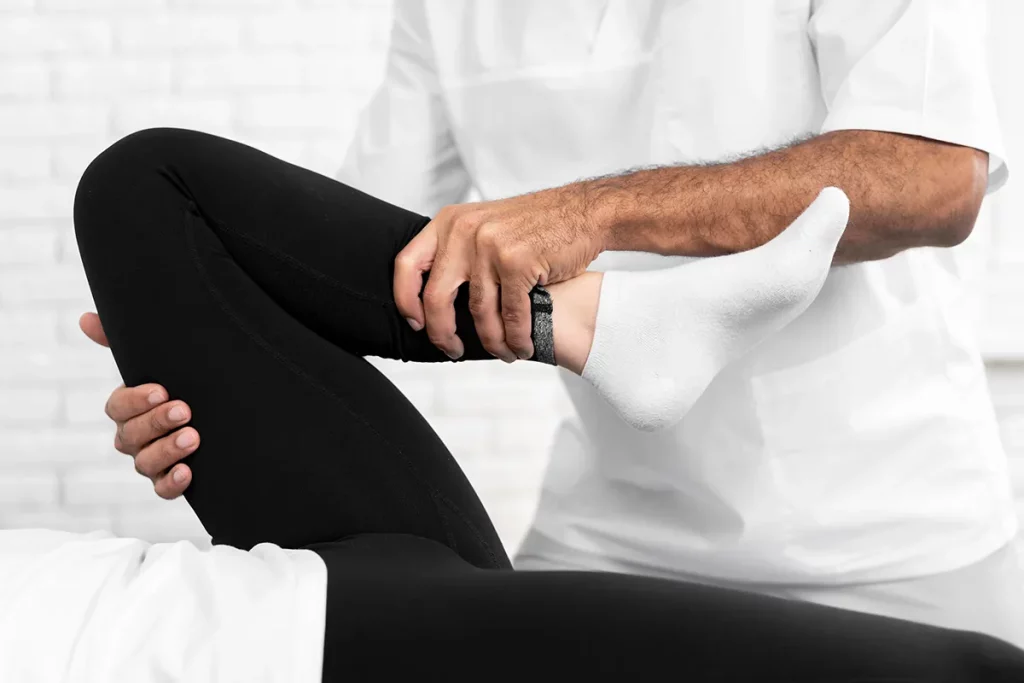Rehabilitation following a Tibia and Fibula fracture

Introduction
Tibia and fibula fractures are injuries requiring appropriate rehabilitation to ensure complete recovery. Rehabilitation plays a fundamental role in recovering the functionality of the lower limb and helping patients to return to their everyday and sporting activities. In this article, we will explore the importance of post-fracture tibia and fibula rehabilitation, providing an overview of the stages involved.
Anatomy of the Tibia and Fibula
The tibia and the fibula are two long bones in the lower limb. The tibia, also called the “shinbone or shankbone”, is the largest bone and is on the inner side of the leg. The fibula is thinner, and is on the external side of the leg. These two bones work together to support the weight of the body and allow the lower leg to move.
The tibia is prism shaped, with an expanded upper portion known as the “tibial plateau” or “tibial plate”. This joint surface connects to the lower end of the femur, forming the knee joint. The lower part of the tibia forms the ankle joint, where it meets the talus, a bone in the foot.
On the other hand, the fibula runs along the outside of the leg and is joined to the lower part of the tibia and the talus. The fibula provides lateral stability to the lower limb and is involved in the plantar flexion and supination of the foot.
Tibia and fibula fractures can occur in any part of these bones, depending on the force and type of trauma. The site and severity of the fracture determine the type of treatment and subsequent rehabilitation required to ensure complete recovery.
Classification of Tibia and Fibula fractures
Tibia and fibula fractures can be classified according to the severity and site of the injury. Fractures may be transverse, oblique or displaced. The classification helps doctors to determine the best treatment for each specific type of fracture. Some fractures may require surgery to reposition the bones and fix them using plates, screws or nails, while others can be treated by immobilisation using a brace or plaster.
What is the best treatment for tibia and fibula fractures
Treatment for tibia and fibula fractures depends on the severity and site of the injury. Having diagnosed the fracture, the doctor will carefully assess the situation and recommend the best treatment. In some cases, surgery may be needed to reposition the bones and fix them using devices such as plates, screws or nails. Other types of fracture can be treated by immobilisation using a brace or plaster. The choice of treatment depends on various factors, including the severity, the age of the patient and their level of activity.
Rehabilitation of tibia and fibula fractures
Rehabilitation begins once the initial healing phase has ended. The physiotherapist plays a key role in the recovery process. Through a combination of manual therapy, specific exercises and mobilisation techniques, the physiotherapist helps to recover strength, flexibility and mobility in the affected limb. During the first rehabilitation phases, the main aim is to reduce pain and swelling and recover the gait cycle, abandoning any crutches used. The physiotherapist may therefore use therapies such as TECAR, ultrasound or manual therapy to relieve pain and stimulate the healing process.
As time passes, rehabilitation will focus on regaining muscle strength, joint mobility and proprioception. Strengthening exercises are gradually introduced to strengthen the thigh, calf and ankle muscles. These may include exercises on a bicycle, bending and stretching the knee with elastic straps, standing on tip-toes, etc. The aim is to improve the strength, stability and coordination of the affected limb.
During rehabilitation, the physiotherapist works closely with the patient to monitor progress, adapt the exercise programme to suit their specific needs and provide advice on how to avoid any complications or new injuries.
Physiotherapy and useful exercises to perform at home
Physiotherapy can be supported by a series of exercises that the patient can perform at home to accelerate recovery. It is important to follow the physiotherapist’s instructions and perform the exercises constantly to obtain the best results.
The exercises may include the strengthening of the lower limb muscles, the flexibility of the affected joints and balance.
Here are a few examples of useful exercises to perform at home:
- Bending and stretching the knee: Lie on your back with the injured leg stretched out. Bend the knee slowly and move the heel towards the gluteus, then stretch the leg slowly out completely. Repeat several series.
- Lifting the heels: Resting on a stable support such as a chair, lift the heels keeping the weight on the tips of the toes. Slow the movement when descending. Repeat several series.
- Balancing on one leg: Stand with the hands on the hips and lift a foot off the ground. Keep your balance on the opposite leg for a few seconds, then lower the foot and repeat with the other leg. Progressively, try to keep your balance for longer and longer.
Conclusion
Rehabilitation following a tibia and fibula fracture is a fundamental process for full recovery and restoring the functionality of the lower limb. With a combination of physical therapy, specific exercises and constant work, patients can recover the strength, flexibility and mobility they need to return to their everyday and sporting activities. It is important to follow the physiotherapist’s instructions and perform the exercises at home too in order to obtain the best results. Remember that every patient and every fracture are unique, so the rehabilitation plan must be adapted individually to meet the specific needs of each person.



